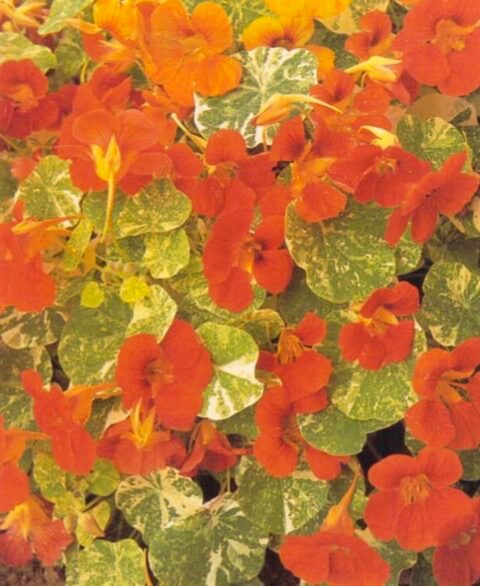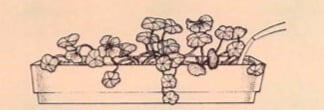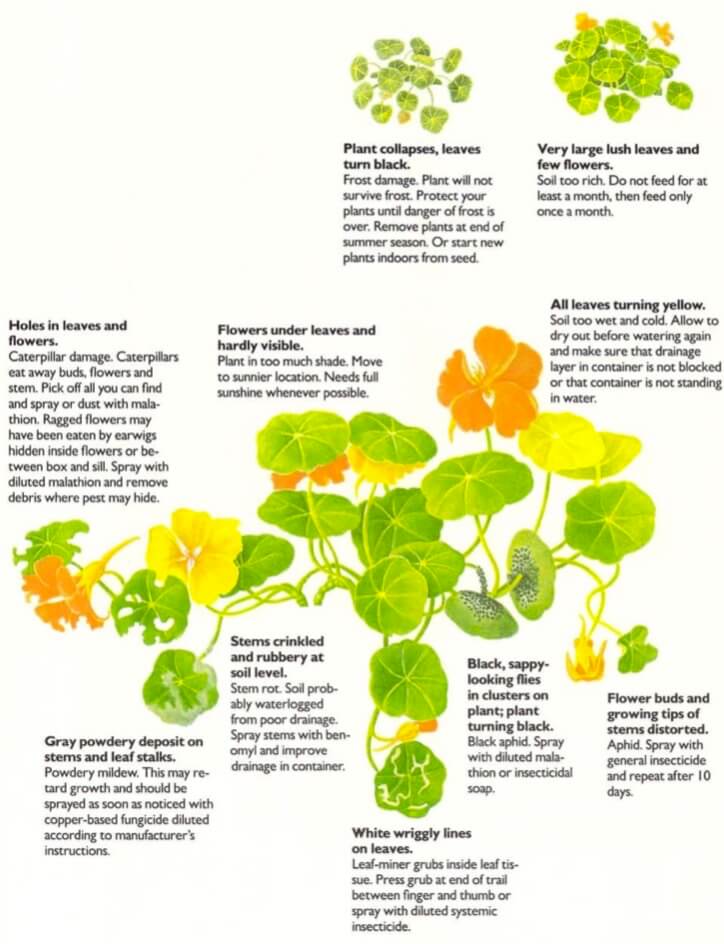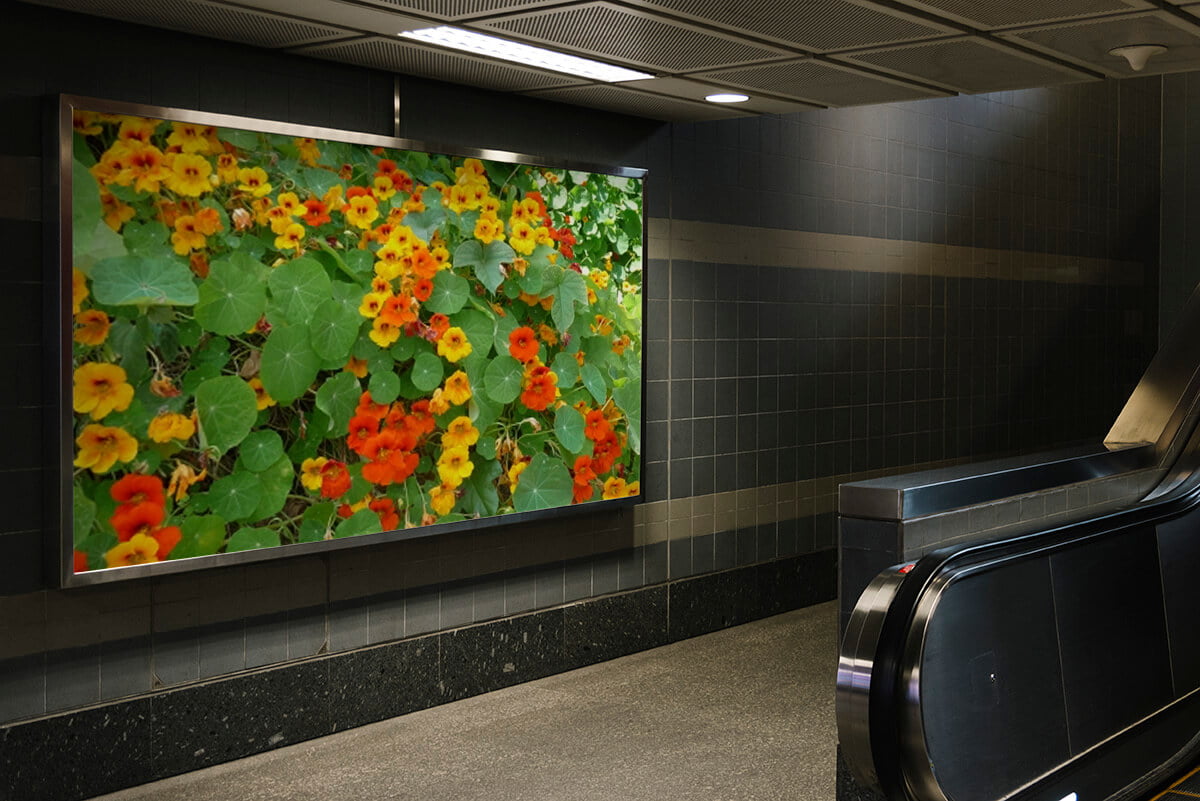[Ebook Việt Hoá] The Instant Guide to Healthy Houseplants (Hướng dẫn tức thời để chăm cây trong nhà khoẻ mạnh), Chi Tropaeolum
[Ebook Việt Hoá] The Instant Guide to Healthy Houseplants: Tropaeolum majus (Garden nasturtium)
- Nguồn: [Ebook Việt Hoá] The Instant Guide to Healthy Houseplants (Hướng dẫn tức thời để chăm cây trong nhà khoẻ mạnh)
- Biên tập: Dũng Cá Xinh
- Biên dịch: Team Codai.net
English
The nasturtium is a fast-growing climbing or trailing plant native to South America. With its array of vibrantly colored Rowers, it pro- vides a brilliant display for any sunny location. If you don’t want a climber, the similar Nasturtium minus, a dwarf, more bushy species, is perfect for window boxes. For covering a trellis, the even-faster-growing Tropaeoleum peregnnum (canary creeper), with its bright yellow Rowers, is superb. All three plants need the same basic treatment.

.
Light
Needs maximum light. Sunshine is essential for lots of flowers.
Temperature
Germination, 45°F(7°C). Tolerates hot conditions well but not frost.
Water
This sappy plant needs moisture in its soil; keep container moist.
Humidity
Prefers dry air; needs no spraying.
Feeding
Feed once a month at manufacturer’s recommended strength. More frequent feeding leads to lush leaves but few flowers.
Soil
Use loam-based soil.
Propagation
Plant pea-sized seeds directly into container loam I inch (24 mm) deep in late spring. Water soil 24 hours beforehand and allow to drain. Allow 6 seeds per 1-ft (30-em) tub or 16 per 4-ft (122-cm) trough. Thin to 3 and 8 seedlings, respectively. Or plant indoors individually in small pots in mid-spring, mov- ing to cold frame when 3 inches (8 em) high. Plant outside in early summer.
Maintenance
Cut off dead flowers once a week. This prolongs flowering.
Cultivars
Gleam hybrids, trailing; Tom Thumb, compact. As the smallest varieties grow to only 6 inches (IS cm), they are suitable for window boxes as well as larger containers. Choose a variety that suits your situation. Tropaeoleum peregrinum is always a climber or trailer.
Watering
Nasturtiums need moist soil, but make sure container is well drained. Check surface of soil daily in hot weather and, if it feels dry and crumbly, add water. If it becomes heavy and does not dry in cold weather, check drainage holes and allow container to dry out before watering again.

What Goes Wrong

- Holes in leaves and flowers: Caterpillar damage. Caterpillars eat away buds, flowers and stem. Pick off all you can find and spray or dust with malathion. Ragged flowers may have been eaten by earwigs hidden inside flowers or between box and sill. Spray with diluted malathion and remove debris where pest may hide.
- Flowers under leaves and hardly visible: Plant in too much shade. Move to sunnier location. Needs full sunshine whenever possible.
- Gray powdery deposit on stems and leaf stalks: Powdery mildew. This may retard growth and should be sprayed as soon as noticed with copper-based fungicide diluted according to manufacturer’s instructions.
- Stems crinkled and rubbery at soil level: Stem rot. Soil probably waterlogged from poor drainage. Spray stems with benomyl and improve drainage in container.
- Black, sappy-looking flies in clusters on plant; plant turning black: Black aphid. Spray with diluted mala- thion or insecticidal soap.
- White wriggly lines on leaves: Leaf-miner grubs inside leaf tissue. Pre’ss grub at end of trail between finger and thumb or spray with diluted systemic insecticide.
- Flower buds and growing tips of stems distorted: Aphid. Spray with general insecticide and repeat after 10 days.
- Plant collapses, leaves turn black: Frost damage. Plant will not survive frost. Protect your plants until danger of frost is over. Remove plants at end of summer season. Or start new plants indoors from seed.
- Very large lush leaves and few flowers: Soil too rich. Do not feed for at least a month, then feed only once a month.
- All leaves turning yellow: Soil too wet and cold. Allow to dry out before watering again and make sure that drainage layer in container is not blocked or that container is not standing in water
Tiếng Việt
Cây sen cạn là một loại cây leo hoặc leo mọc nhanh có nguồn gốc từ Nam Mỹ. Với một loạt cây có màu sắc rực rỡ, nó mang đến một bức màn rực rỡ cho bất kỳ vị trí nắng nào. Nếu bạn không thích cây leo, loài Nasturtium tương tự, một loài lùn, rậm rạp hơn, là lựa chọn hoàn hảo cho các ô cửa sổ. Cây Tropaeoleum peregnnum (canary creeper) phát triển rất nhanh, với màu vàng tươi của nó tạo thành một giàn là tuyệt vời. Cả ba loại cây này cần chăm sóc cơ bản giống nhau.

.
Ánh sáng
Cần ánh sáng tối đa. Ánh nắng mặt trời là điều cần thiết để ra rất nhiều hoa.
Nhiệt độ
Nảy mầm ở 45 ° F (7 ° C). Thích nghi tốt điều kiện nóng nhưng không bị sương giá.
Nước
Loài cây tươi tốt này cần độ ẩm trong đất; giữ ẩm cho thùng chứa.
Độ ẩm
Thích không khí khô; không cần phun.
Bón phân
Bón phân mỗi tháng một lần với nồng độ khuyến nghị của nhà sản xuất. Bón phân thường xuyên hơn dẫn đến lá tươi tốt nhưng ít hoa.
Đất
Sử dụng đất thịt.
Nhân giống
Gieo hạt nhỏ bằng hạt đậu trực tiếp vào thùng chứa mùn sâu 24 mm vào cuối mùa xuân. Tưới nước cho đất trước 24 giờ và để ráo nước. Cho 6 hạt vào mỗi khay 1 ft (30 cm) hoặc 16 hạt vào khay 4 ft (122 cm). Mọc thành 3 và 8 cây con tương ứng. Hoặc trồng riêng lẻ trong nhà trong các chậu nhỏ vào giữa mùa xuân, chuyển sang giàn lạnh khi cao 3 inch (8 cm). Trồng ngoài trời vào đầu mùa hè.
Duy trì
Cắt bỏ hoa tàn mỗi tuần một lần. Điều này kéo dài thời gian ra hoa.
Các loài
Gleam hybrids, cây bò; Tom Thumb, nhỏ gọn. Vì các giống nhỏ nhất chỉ phát triển đến 6 inch (15 cm), chúng thích hợp cho các ô cửa sổ cũng như các thùng chứa lớn hơn. Chọn nhiều loại phù hợp với điều kiện của bạn. Tropaeoleum peregrinum luôn là cây leo hoặc cây bò.
Tưới nước
Cây sen cạn cần đất ẩm, nhưng đảm bảo giá thể thoát nước tốt. Kiểm tra bề mặt đất hàng ngày khi thời tiết nóng và nếu thấy khô và vụn, hãy thêm nước. Nếu nó trở nên nặng và không khô trong thời tiết lạnh, hãy kiểm tra các lỗ thoát nước và để thùng chứa khô trước khi tưới lại.

Những vấn đề có thể xảy ra

- Lỗ trên lá và hoa: Sâu tơ gây hại. Sâu bướm ăn chồi, hoa và thân cây. Nhặt tất cả những gì bạn thấy và xịt hoặc làm sạch bụi bằng malathion. Những bông hoa xù xì có thể đã bị ăn bởi những con cuốn chiếu ẩn bên trong hoa hoặc giữa bệ cửa. Phun malathion pha loãng và loại bỏ các mảnh vụn nơi sâu bệnh có thể ẩn náu.
- Hoa dưới lá và hầu như không nhìn thấy: Trồng trong bóng râm quá nhiều. Di chuyển đến vị trí nhiều nắng hơn. Cần ánh nắng đầy đủ bất cứ khi nào có thể.
- Phấn trắng đóng cặn trên thân và cuống lá: Bệnh phấn trắng. Điều này có thể làm chậm sự phát triển và cần được phun ngay bằng thuốc copper fungicide pha loãng theo hướng dẫn của nhà sản xuất.
- Thân nứt nẻ ở tầng đất: Thối thân. Đất có thể bị úng do thoát nước kém. Phun benomyl lên thân cây và cải thiện hệ thống thoát nước trong thùng chứa.
- Những con ruồi đen, trông có vẻ khô ráp; cây chuyển sang màu đen: Rệp đen. Phun với malathion pha loãng hoặc xà phòng diệt côn trùng.
- Đường nhăn trắng trên lá: Sâu đục bên trong mô lá. Bắt ấu trùng ở cuối đường vạch bằng ngón cái hoặc phun thuốc trừ sâu toàn thân đã được pha loãng.
- Chồi hoa và đầu cành mọc méo mó: Rệp. Phun thuốc trừ sâu tổng hợp và lặp lại sau 10 ngày.
- Cây cối đổ rạp, lá chuyển màu đen: Thiệt hại do sương giá. Cây sẽ không tồn tại trong sương giá. Bảo vệ cây của bạn cho đến khi băng giá qua đi. Loại bỏ cây trồng vào cuối mùa hè. Hoặc bắt đầu trồng cây mới trong nhà từ hạt giống.
- Rất nhiều lá tươi tốt và ít hoa: Đất quá giàu dinh dưỡng. Không bón phân trong ít nhất một tháng, sau đó chỉ bón phân mỗi tháng một lần.
- Tất cả các lá chuyển sang màu vàng: Đất quá ẩm và lạnh. Để khô trước khi tưới lại và đảm bảo rằng lớp thoát nước trong thùng chứa không bị tắc hoặc thùng không đọng nước.



